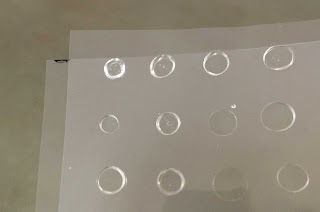One of the first things I did when I started working at Pioneer Park Museum was to apply for the Museum of of Applied Arts and Sciences' Regional Program.
We were successful in our applications for a visit from a curator, which is planned for July, and a conservation workshop that we held last week. There were 16 people in attendance, including visitors from the Yanco Powerhouse Museum and other historical groups in the Western Riverina.
Gosia Dudek from the Powerhouse Museum in Sydney showed a variety of techniques and technologies for conserving and presenting historical objects. For example, in the foreground of the picture on the right you can make out supports that were designed to hold books open in displays. These were made from acid-free card.
She explained there had been a move away from restoration, as history was sometimes lost when substituting for original materials. The result was a focus on preventative conservation to prevent further deterioration.
It was outlined that the main causes of damage were handling, UV light, fluctuating temperatures, pests and contaminants. Some damage, such as light, can occur over time, so it is cumulative. The ideal conditions for storage are a temperature range of 16-22C with humidity at between 45-60%.
Gosia demonstrated a range of ideas that had practical applications. She showed how to mount paper-based items using corners to avoid damage.
It was interesting that the adhesive can be an issue. She showed that it important to ensure the corner is applied around the mounting board, so that the adhesive is kept away from the object being presented.
Images were also shown to benefit from frames, both for conservation and aesthetics. It was one of those lessons I remember learning when I first studied photography, how a solid border provides contrast to the image mounted within.
This frame added effective contrast, with the dark blue colour making the warmer hues of the photograph 'pop'. It was easily constructed from card and I was surprised how much it elevated the quality of the print. Using acid-free card was emphasised to prevent the long-term impact of the material on the object.
When this frame was lifted, it was revealing to see the image was obviously cut from a newspaper. It seemed a beaut example of how a little effort in presentation raises the appeal of the object.
The walk around the Park with Gosia also provided simple and applicable steps for presentation and conservation. She pointed out that it wasn't just the artificial lights that required UV filters when we looked at displays that were facing open doorways and saw the need to install film that would reduce the light spectrum.
She also observed that the hairbrushes on display were resting on their bristles, which would bend under the weight of the brush handle. Also that the Matchbox cars needed better support, both for the cardboard packaging that was warping under the weight of being propped upright and the impact of the cars metal chassis on the rubber wheels of those on display.
Polythylene terephthalate glycol was one technology that seemed to be revolutionary in allowing curators to make displays. This plastic could be cut with scissors and folded to create the kinds of supports that would have required skills in manipulating heavier sheets of plastic in the past.
Vibration was an issue that Gosia said she'd become more aware of
recently. The Powerhouse Museum in Sydney had seen evidence of objects
on display shifting through vibration, although this wasn't as
pronounced as what a museum located at Christchurch in New Zealand had
witnessed after an earthquake.
In that example she said the use of these resin spots placed under objects had saved many from falling. Gosia demonstrated how these were created with small spots of Rhoplex applied onto Mylar sheeting with a wooden skewer.
The workshop was a great opportunity to have my eyes opened to issues of conservation and presentation. It was also great to provide the Park as a focus for local historical societies and other individuals, with the 16 people there comparing notes on a range of subjects.





